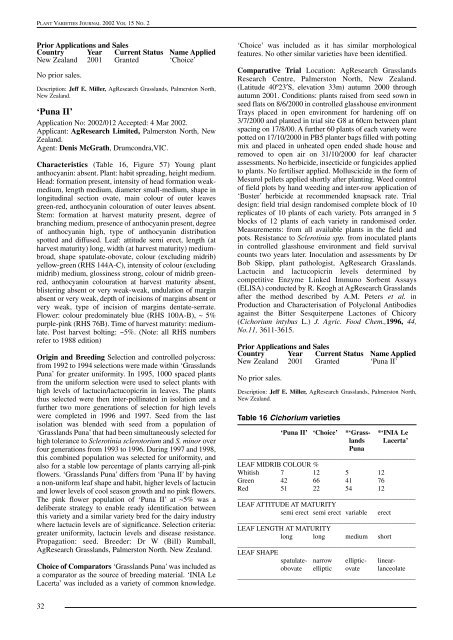44. Volume 15- Number 2 - IP Australia
44. Volume 15- Number 2 - IP Australia
44. Volume 15- Number 2 - IP Australia
Create successful ePaper yourself
Turn your PDF publications into a flip-book with our unique Google optimized e-Paper software.
PLANT VARIETIES JOURNAL 2002 VOL <strong>15</strong> NO. 2<br />
Prior Applications and Sales<br />
Country Year Current Status Name Applied<br />
New Zealand 2001 Granted ‘Choice’<br />
No prior sales.<br />
Description: Jeff E. Miller, AgResearch Grasslands, Palmerston North,<br />
New Zealand.<br />
‘Puna II’<br />
Application No: 2002/012 Accepted: 4 Mar 2002.<br />
Applicant: AgResearch Limited, Palmerston North, New<br />
Zealand.<br />
Agent: Denis McGrath, Drumcondra,VIC.<br />
Characteristics (Table 16, Figure 57) Young plant<br />
anthocyanin: absent. Plant: habit spreading, height medium.<br />
Head: formation present, intensity of head formation weakmedium,<br />
length medium, diameter small-medium, shape in<br />
longitudinal section ovate, main colour of outer leaves<br />
green-red, anthocyanin colouration of outer leaves absent.<br />
Stem: formation at harvest maturity present, degree of<br />
branching medium, presence of anthocyanin present, degree<br />
of anthocyanin high, type of anthocyanin distribution<br />
spotted and diffused. Leaf: attitude semi erect, length (at<br />
harvest maturity) long, width (at harvest maturity) mediumbroad,<br />
shape spatulate-obovate, colour (excluding midrib)<br />
yellow-green (RHS 144A-C), intensity of colour (excluding<br />
midrib) medium, glossiness strong, colour of midrib greenred,<br />
anthocyanin colouration at harvest maturity absent,<br />
blistering absent or very weak-weak, undulation of margin<br />
absent or very weak, depth of incisions of margins absent or<br />
very weak, type of incision of margins dentate-serrate.<br />
Flower: colour predominately blue (RHS 100A-B), ~ 5%<br />
purple-pink (RHS 76B). Time of harvest maturity: mediumlate.<br />
Post harvest bolting: ~5%. (Note: all RHS numbers<br />
refer to 1988 edition)<br />
Origin and Breeding Selection and controlled polycross:<br />
from 1992 to 1994 selections were made within ‘Grasslands<br />
Puna’ for greater uniformity. In 1995, 1000 spaced plants<br />
from the uniform selection were used to select plants with<br />
high levels of lactucin/lactucopicrin in leaves. The plants<br />
thus selected were then inter-pollinated in isolation and a<br />
further two more generations of selection for high levels<br />
were completed in 1996 and 1997. Seed from the last<br />
isolation was blended with seed from a population of<br />
‘Grasslands Puna’ that had been simultaneously selected for<br />
high tolerance to Sclerotinia sclerotorium and S. minor over<br />
four generations from 1993 to 1996. During 1997 and 1998,<br />
this combined population was selected for uniformity, and<br />
also for a stable low percentage of plants carrying all-pink<br />
flowers. ‘Grasslands Puna’ differs from ‘Puna II’ by having<br />
a non-uniform leaf shape and habit, higher levels of lactucin<br />
and lower levels of cool season growth and no pink flowers.<br />
The pink flower population of ‘Puna II’ at ~5% was a<br />
deliberate strategy to enable ready identification between<br />
this variety and a similar variety bred for the dairy industry<br />
where lactucin levels are of significance. Selection criteria:<br />
greater uniformity, lactucin levels and disease resistance.<br />
Propagation: seed. Breeder: Dr W (Bill) Rumball,<br />
AgResearch Grasslands, Palmerston North. New Zealand.<br />
Choice of Comparators ‘Grasslands Puna’ was included as<br />
a comparator as the source of breeding material. ‘INIA Le<br />
Lacerta’ was included as a variety of common knowledge.<br />
‘Choice’ was included as it has similar morphological<br />
features. No other similar varieties have been identified.<br />
Comparative Trial Location: AgResearch Grasslands<br />
Research Centre, Palmerston North, New Zealand.<br />
(Latitude 40º23′S, elevation 33m) autumn 2000 through<br />
autumn 2001. Conditions: plants raised from seed sown in<br />
seed flats on 8/6/2000 in controlled glasshouse environment<br />
Trays placed in open environment for hardening off on<br />
3/7/2000 and planted in trial site G8 at 60cm between plant<br />
spacing on 17/8/00. A further 60 plants of each variety were<br />
potted on 17/10/2000 in PB5 planter bags filled with potting<br />
mix and placed in unheated open ended shade house and<br />
removed to open air on 31/10/2000 for leaf character<br />
assessments. No herbicide, insecticide or fungicides applied<br />
to plants. No fertiliser applied. Molluscicide in the form of<br />
Mesurol pellets applied shortly after planting. Weed control<br />
of field plots by hand weeding and inter-row application of<br />
‘Buster’ herbicide at recommended knapsack rate. Trial<br />
design: field trial design randomised complete block of 10<br />
replicates of 10 plants of each variety. Pots arranged in 5<br />
blocks of 12 plants of each variety in randomised order.<br />
Measurements: from all available plants in the field and<br />
pots. Resistance to Sclerotinia spp. from inoculated plants<br />
in controlled glasshouse environment and field survival<br />
counts two years later. Inoculation and assessments by Dr<br />
Bob Skipp, plant pathologist, AgResearch Grasslands.<br />
Lactucin and lactucopicrin levels determined by<br />
competitive Enzyme Linked Immuno Sorbent Assays<br />
(ELISA) conducted by R. Keogh at AgResearch Grasslands<br />
after the method described by A.M. Peters et al. in<br />
Production and Characterisation of Polyclonal Antibodies<br />
against the Bitter Sesquiterpene Lactones of Chicory<br />
(Cichorium intybus L.) J. Agric. Food Chem.,1996, 44,<br />
No.11, 3611-36<strong>15</strong>.<br />
Prior Applications and Sales<br />
Country Year Current Status Name Applied<br />
New Zealand 2001 Granted ‘Puna II’<br />
No prior sales.<br />
Description: Jeff E. Miller, AgResearch Grasslands, Palmerston North,<br />
New Zealand.<br />
Table 16 Cichorium varieties<br />
‘Puna II’ ‘Choice’ *‘Grass- *‘INIA Le<br />
lands Lacerta’<br />
Puna<br />
____________________________________________________<br />
LEAF MIDRIB COLOUR %<br />
Whitish 7 12 5 12<br />
Green 42 66 41 76<br />
Red 51 22 54 12<br />
____________________________________________________<br />
LEAF ATTITUDE AT MATURITY<br />
semi erect semi erect variable erect<br />
____________________________________________________<br />
LEAF LENGTH AT MATURITY<br />
long long medium short<br />
____________________________________________________<br />
LEAF SHAPE<br />
spatulate- narrow elliptic- linearobovate<br />
elliptic ovate lanceolate<br />
____________________________________________________<br />
32

















